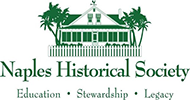Educational Programs
Educational programs offered at Naples Historical Society’s Historic Palm Cottage!
Our Tours
Our Events
Naples Calusa Indian Canal
More than 1,000 years ago the canal ran from what is now 9th Avenue South on the Gulf of Mexico to 13th Avenue South on Naples Bay. The canal functioned as a safe water passage for canoes navigating from the Bay to the Gulf, and perhaps even as a shortcut to the Indian King Carlos’ headquarters on Mound Key in Estero Bay.
Radio carbon dates suggest the canal was in use from circa A.D. 700 to A.D. 1400. More precise dates are a part of the ongoing research effort, which will include sub-surface excavation “digs” to carbon-date additional organic matter from the Naples canal, and to uncover any artifacts that might remain laying in the bottom.
Historical Perspective
Native Americans, dominated by the indigenous Calusa tribe, created this engineering marvel when they dug the Canal from the Gulf at 9th Avenue South, to a point on the Bay around 13th Ave South close to the Naples City Docks. The Indian Canal is almost a mile long.
The Smithsonian Institute funded an expedition of the Indian Canal in 1877, with the measurements from that expedition indicating that the Canal was 40 feet wide and resting up to 25 feet below the forest floor in some places.
While archaeologists were exploring the Canal, they learned that many Calusa artifacts were being unearthed from the muck out on Marco Island, leading to the expedition that discovered the infamous Key Marco Cat, some fabulous Indian Masks, and many other treasures that are now housed at the Smithsonian Institute.
Most of the Naples Indian Canal was covered over by the 1920’s in order to make room for real estate development in Old Naples. Its existence might have been forgotten had it not been surveyed on the original plat map of Naples in 1887 by the original developers, the Naples Land Company.
